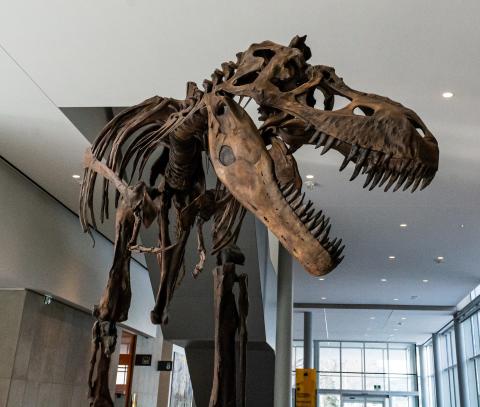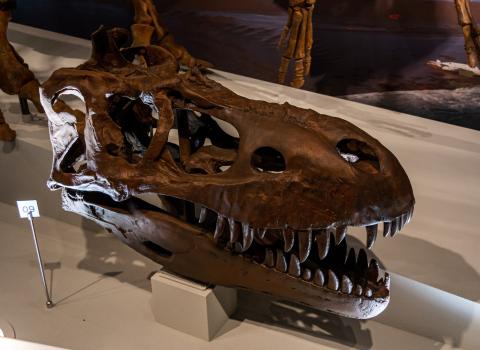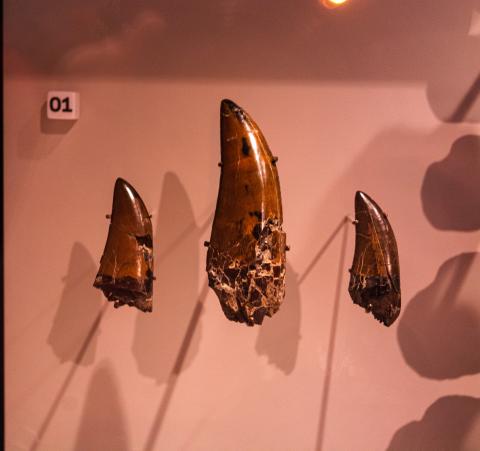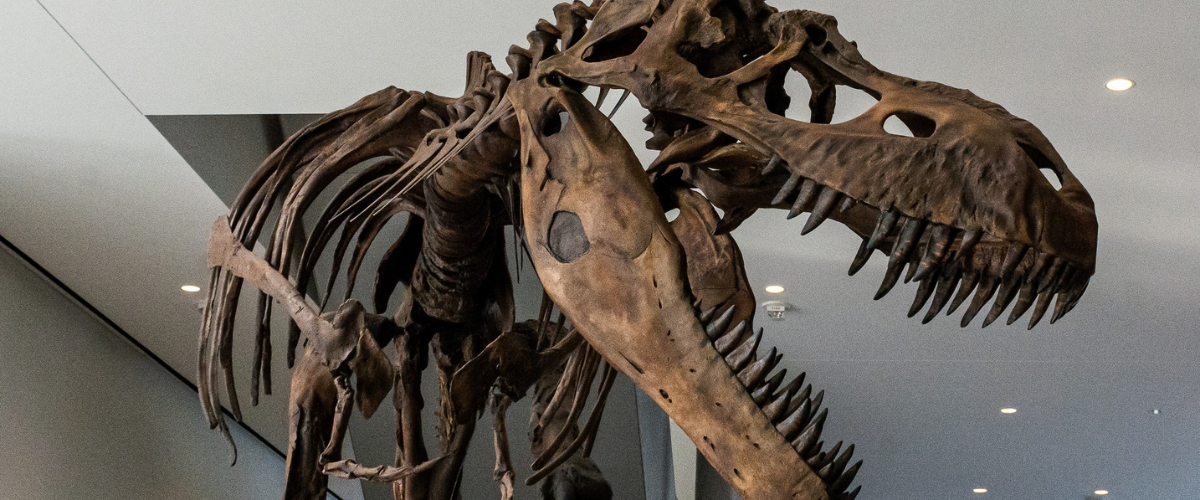Albertosaurus, A Dinosaur of Our Own
Nick Carter, Marketing and Communications Volunteer
Isn’t it fitting that visitors to the Royal Alberta Museum are greeted by a skeleton of the dinosaur Albertosaurus? This carnivore, one of the two-legged theropod dinosaurs, was given its name in 1905 to commemorate the newly-established province it was found in (Osborn, 1905).

As a member of the tyrannosaur family, reaching sizes of up to 9 meters long and 3 tons in weight (Campione et al., 2014), Albertosaurus was a large and formidable predator. Not as big as the later Tyrannosaurus rex, Albertosaurus was part of its own distinct subfamily alongside the very similar Gorgosaurus, another classic Alberta dinosaur. They had relatively long lower leg and foot bones, an indication that these carnivores were fast runners for their body size. Despite its nimble build, the large serrated teeth and strong jaw muscles of Albertosaurus still made it a powerful hunter.
Albertosaurus fossils date back to the late Cretaceous period, between 71 and 68 million years ago and come from a layer of rock called the Horseshoe Canyon Formation. This rock formation is famously seen in the badlands along the Red Deer River in places like the Drumheller area, where Albertosaurus remains were first discovered and still continue to be found today. Exposures of this rock can also be seen along the North Saskatchewan River in and around Edmonton, and Albertosaurus fossils have been found right inside the city. At least some of the tyrannosaur tracks and shed teeth from equivalent-aged rocks near Grande Prairie might belong to this species as well.
During this time, much of central Alberta was a strip of flat, swampy lowlands between the Rocky Mountains to the west and the Western Interior Seaway to the east that divided North America in half during parts of the Cretaceous. Albertosaurus was the largest predator in its environment. It lived alongside (and may have preyed on) a variety of plant-eating dinosaurs as well as smaller, birdlike theropod dinosaurs and flying pterosaurs. Also around at the time were creatures that would be more familiar to us today, such as crocodilians, turtles, lizards and snakes, and different sorts of marsupial mammals.

Palaeontologists have wondered whether or not Albertosaurus was a social dinosaur, potentially living and hunting in packs. This idea comes from the discovery of an Albertosaurus bonebed in Dry Island Buffalo Jump Provincial Park in southern Alberta. Initially found in 1910 by American fossil hunter Barnum Brown and rediscovered in 1997 by Alberta palaeontologist Philip Currie, this bonebed contains at least 12 individuals of Albertosaurus ranging from small juveniles to massive adults (Currie, 1998). Were at least some of these animals actually living together, or is this bonebed made up of lone individuals that died and became buried together for some other reason, like a natural disaster? Scientists have argued for both sides, but either way, it’s an intriguing puzzle.
In the RAM Natural History Hall, you can view shed Albertosaurus teeth recovered from the Edmonton river valley. This site, called the Danek bonebed, is mostly made up of the appropriately-named herbivore Edmontosaurus, one of the “duck-billed” dinosaurs, along with a variety of other species including fossils of Albertosaurus (Torices et al., 2014). In this deposit a herd of Edmontosaurus somehow died, and the shed tyrannosaur teeth may indicate that the herbivores had been scavenged on at some point by multiple Albertosaurus. As the predators went about eating, which in tyrannosaurs like this involved a lot of bone-crunching, they occasionally lost teeth which fossilized alongside their prey. While in mammals like us losing a tooth in adulthood normally means a trip to the dentist, dinosaurs routinely replaced old, worn, or broken teeth throughout their lives, and Albertosaurus was no exception. Some modern animals like crocodiles are capable of the same thing.

A few skull bones from Albertosaurus also found at the Danek bonebed show that at least one unlucky individual somehow died during or close to the burial of the Edmontosaurus herd and became preserved alongside them (Bell & Currie, 2014). Newer research has also revealed an Albertosaurus pubic bone from this site with tooth marks on it, indicating that the dinosaur it came from had been fed on by members of its own kind in an instance of cannibalistic scavenging (Coppock & Currie, 2024).
There’s the Albertosaurus for you. An interesting dinosaur to be sure, and something we as Albertans can take pride in every time we step through the museum doors again… or at least every time we take a look at our driver’s licenses.
References
Bell P.R. and Currie P.J. 2014. Albertosaurus (Dinosauria: Theropoda) material from an Edmontosaurus bonebed (Horseshoe Canyon Formation) near Edmonton: clarification of palaeogeographic distribution. Can. J. Earth Sci. 51: 1–6 (2014) dx.doi.org/10.1139/cjes-2014-0050
Campione, N. E.; Evans, D. C.; Brown, C. M.; Carrano, M. T. (2014). "Body mass estimation in non-avian bipeds using a theoretical conversion to quadruped stylopodial proportions". Methods in Ecology and Evolution. 5 (9): 913−923.
Colton C. Coppock, Philip J. Currie. 2024. Additional Albertosaurus sarcophagus (Tyrannosauridae, Albertosaurinae) material from the Danek bonebed of Edmonton, Alberta, Canada with evidence of cannibalism. Can J. Earth Sci. 61: 401-407 (2024) https://doi.org/10.1139/cjes-2023-0055.
Currie, Philip J. (1998). "Possible evidence of gregarious behaviour in tyrannosaurids" (PDF). Gaia. 15: 271–277.
Osborn, H.F. (December 31, 1905). "Tyrannosaurus and other Cretaceous carnivorous dinosaurs". Bulletin of the American Museum of Natural History. 21: 259–265. doi:10.5281/zenodo.1038222.
Torices A., Reichel M., and Currie P.J. 2014b. Multivariate analysis of isolated tyrannosaurid teeth from the Danek Bonebed, Horseshoe Canyon Formation, Alberta, Canada. Can. J. Earth Sci. 51: 1045–1051 (2014) dx.doi.org/10.1139/cjes-2014-0072
